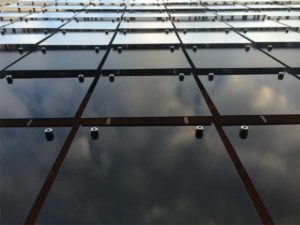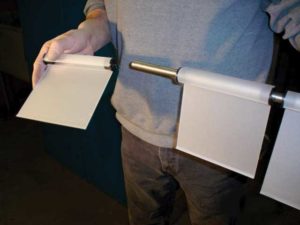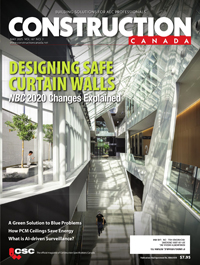Kinetic façade systems: Adding a dynamic element to building structures

For ease of delivery and installation, each of these suspension systems is typically factory-unitized. Dimensions commonly range from 1 x 1.2 m (3 x 4 ft) to 1.5 x 3.7 m (5 x 12 ft) in vertical or horizontal orientations.
For optimal cost and performance value, the drop-in suspension system is recommended. In this configuration, T-shaped kinetic flappers are easily inserted into a specially designed ‘rung’ extrusion system, significantly reducing the amount of time and labour required for fabrication.
The pin-mount suspension system allows the flapper elements to seemingly float in front of the support rungs and side rails as a veil. This configuration minimizes the appearance of the supporting structure. The pin-mount system allows for mixing flapper shapes to create geometric patterns and for installation at various mounting points, facilitating changes in kinetic activity.
Drop-in and pin-mount suspension systems allow the flappers to be removed and replaced without any specialized tools if repair or maintenance is needed. Both systems also accommodate up to a 90-degree range of motion.
Offering a 360-degree range of motion for the individual flappers, the rod-mount suspension system allows for greater intermittent views through the kinetic façade and minimizes the appearance of the horizontal supporting structure from within the building. They can also permit increased airflow and promote passive cooling. The vertical side rails are typically more prominent within the façade and the flappers can be replaced with simple tools.
Some manufacturers also offer cable-mount suspension systems. These systems suspend the kinetic elements or flappers between a combination of horizontal and/or vertical cables. The flapper replacement for cable-mount systems can involve costly and time-consuming restringing or replacement of the entire cable section.

Performance considerations
Performance requirements are important on every building, and deserve extra attention with kinetic façade systems. Careful analysis is needed regarding the interaction between the kinetic façade elements and the building structure to which it is attached, as well as the impact of the structural behaviour on the design and cost of the system.
Structural loads, especially those due to positive and negative wind pressures, need to be assessed to ensure the façade system meets the required strength specifications and the esthetic requirements. Other loads that are influential in the specification, design, and installation of the kinetic façade include ice and snow loads and seismic loads.
The method of attaching the façade elements to the building also needs to be examined and coordinated as early as possible during the design and specification phase. For example, will the kinetic panels be self-supporting, or will secondary supports need to be installed? In concrete structures, this means evaluating their embeds and anchors, their interaction with existing reinforcement configurations, and their required supporting system.
The kinetic façade system also needs to be compatible with anticipated building movements. The attachment design should account for the dynamic deflections of various types of buildings and structural systems. In parking structures, for example, the dynamic deflections from vehicle traffic must be adequately taken into account. Kinetic façade systems that cannot accommodate the required deflections run the risk of failure. It is, therefore, crucial that mounting systems are designed for these deflections to ensure long-term integrity of the system is maintained. Close co-ordination between the façade designer and manufacturer, and the engineer of record for the supporting building structure is critical even in the early phases of the design process.
A building’s structural demands may also govern the testing requirements of the kinetic façade, such as ASTM E-330/E-330M, Structural Performance of Exterior Windows, Doors, Skylights and Curtain Walls by Uniform Static Air Pressure Difference, which is referenced in the 2015 National Building Code of Canada (NBC). These testing requirements are often driven by local codes, however, the desired façade performance may be the determining factor.
Budget considerations
A project’s design and specification phase is the best time to critically analyze esthetic and performance requirements, and to make adjustments to ensure its success. Once the project moves into fabrication and installation, corrections become more costly.
Budgeting for a kinetic façade system usually entails striking a balance between the desired esthetic and performance goals of the project. Since kinetic façade systems are delivered to a jobsite in pre-assembled units, most installations range from $9 to $15 per 1 m2 (10 sf), depending on several factors plus labour costs.







